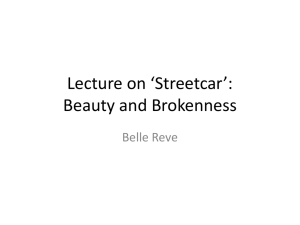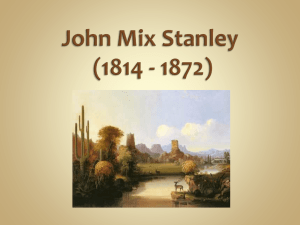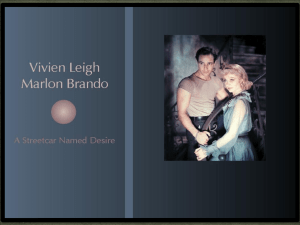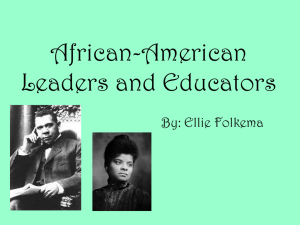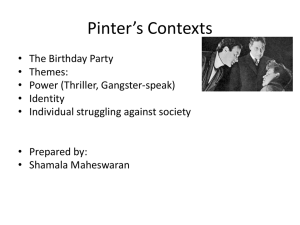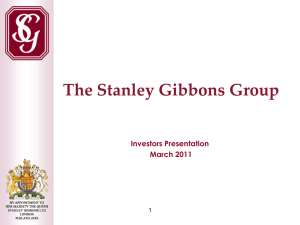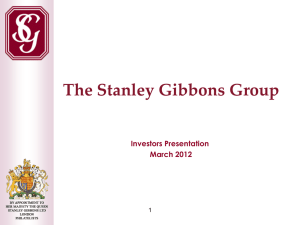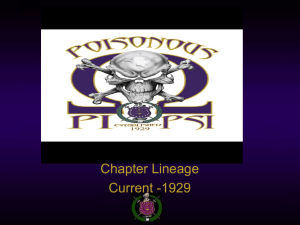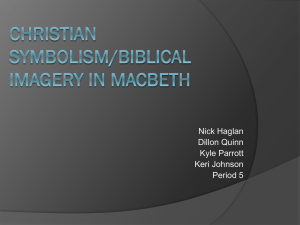A StREETCAR NAMED DESIRE
advertisement
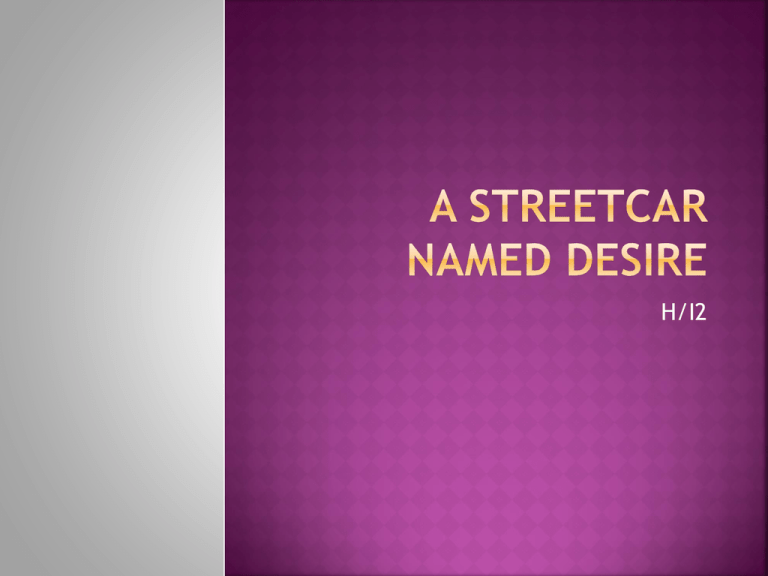
H/I2 Most plays are written with an audience in mind, not to be studied as a literary work. We always therefore, refer to the audience instead of the reader However we can still study a playwright’s intentions and the world created on the stage Tennessee Williams in particular gives detailed stage directions that help the actors bring the characters to life. First reading of the play Study the film version Second, in-depth reading of the play with focus on themes, literary and dramatic techniques and devices Tennessee Williams (March 26, 1911 – February 25, 1983) Williams is thought to have been able to identify with a fragility and vulnerability in women and once said: “I draw every character out of my very vulnerable split personality. My heroines always express the climate of my interior world at the time in which those characters were created” He found examples of universal experience in the fringes of acceptable behaviour – maybe this relates to his personal experiences. 1. What does Williams' depiction of Blanche and Stanley’s lives say about desire? 2. The plot of A Streetcar Named Desire is driven by the dueling personalities of Blanche and Stanley. What are the sources of their animosity toward one another? 3. A Streetcar Named Desire can be described as an elegy, or poetic expression of mourning, for an Old South that died in the first part of the twentieth century. Do you agree? As a Southerner, he was affected by the events of the American Civil War (1861 – 1865). Following their defeat by the Northern States, the South suffered economically. However, this air of decaying grandeur added to the romantic appeal for Williams. As time moved on, industrialisation continued into the cities. Whilst the plantations continued to decay, urban growth and capitalism flourished in the cities. Williams was interested in the process of American history – not only where it had been, but also where it was going and how it would get there. Stanley represents the American Dream where all men are born equal and can succeed equally, whilst Blanche represents the Old World, where class and race are still important issues. Williams was homosexual and whilst this is clearly an aspect of his work (think of Blanche’s dead husband Alan), it is important to remember that for most of his life, homosexuality remained illegal. It was however tolerated in some places such as New Orleans. Women in the Old South had a social and symbolic role, were expected to be passive and chaste. This world could not give what Blanche wanted and needed, so she tried to marry into the ‘light and culture’ yet she discovers that there is corruption and deceit behind this facade. Blanche and Stanley are from different worlds where money has different values. The tensions in the play come partly from cultural conflict – the worlds of Stanley and Blanche are so opposed that neither can understand each other. The play is an example of the “Southern Gothic” – texts set in America’s South with overtones of supernatural or unusual events (such as Blanche’s madness) Tennessee Williams described Southern Gothic as a style that captured "an intuition, of an underlying dreadfulness in modern experience.“ The play is also an example of social realism (all the events are ordinary and realistic, such as the domestic arguments etc) “A Streetcar named Desire” refers literally to the streetcar Blanche takes to reach Stella’s house but also reflects the trajectory of Blanche’s life. She has always been driven by desire. The streetcar stops at “Cemeteries” pointing to the tragedy experienced by Blanche and directly connecting death and desire Then finally stops at “Elysian Fields” – the Greek place of the dead. Blanche finds herself enduring a “living death” in an asylum. Williams initially entitled the play “The Moth” which would have put much more focus on Blanche as a character. The play offers a romanticized vision of slum life that nevertheless reflects the atypical characteristics of New Orleans. The mix of characters and social elements around Elysian Fields demonstrates the way New Orleans has historically differed from other American cities in the South. It was originally a Catholic settlement (unlike most Southern cities, which were Protestant), and consequently typical Southern social distinctions were ignored. Hence, blacks mingle with whites, and members of different ethnic groups play poker and bowl together. Stanley, the son of Polish immigrants, represents the changing face of America. Williams’s romanticizing is more evident in his portrayal of New Orleans as a city where upper-class people marry members of the lower class, fights get ugly but are forgotten the next day, and the perpetual bluesy notes of an old piano take the sting out of poverty. A gothic American writer – wrote fiction concerned with the supernatural and madness. Blanche refers to him at several points – she compares New Orleans to the Forest of Weir (Poe’s poem Ulalume which is concerned with death of the female and a dreamlike reality). This also reminds the audience that Blanche is an English teacher. Blanche arrives at the symbolically named “Elysian Fields” – reference to the Greek Underworld heaven and also ironic, Stella lives in a shabby neighbourhood. Blanche is compared to a “moth” suggesting her fragility and her attraction to “light” (culture and positivity). Introduces Blanche’s thinly masked alcoholism – Stanley notices this from the start “Liquor goes fast in hot weather”. Blanche’s alcoholism is stressed by her repetitive action of drinking throughout the play. Motifs: the blue piano (sets the mood throughout the play) which represents the multicultural, upbeat spirit of New Orleans – the new South where black and white mingle. The polka: alerts the audience to the fact that Blanche’s dead husband is important. It also suggests she is “haunted” by the memory of her dead husband, Allan. Blanche’s character is revealed here: her awareness of social distinction (the way she accepts Eunice and her neighbour’s kindnesses as if she expects them) and her dismay at Stella’s way of life. Blanche is the play’s focus . Williams turns Greek tragedy on its head in this play by subverting the norm of a Greek tragedy in which a noble hero suffers a downfall. Instead Williams charts the downfall of a vain, deluded, promiscuous woman and creates a sense of pity and fear towards her. Blanche’s constant need for flattery suggests her vanity and fear of losing her looks (a fading Southern Belle) creating pathos (a strong sense of pity for her) In this scene, Williams paints the picture of the sisters’ relationship – when Blanche retells the stories of the family deaths at Belle Reve she is accusatory towards Stella. She claims Stella has been selfish and indifferent while she “fought and bled” for Belle Reve compared to Stella who she reproaches for being “in bed with your Polack” – a double insult. “I let the place go!” – Stella had not accused her sister of letting Belle Reve (beautiful dream) go. Blanche’s words here reveal her and are self-accusatory. She is also out for sympathy from Stella. Do you think that Blanche genuinely has no idea why the family plantation had to be sold, or is she unwilling to admit her part in it? Blanche’s obsession with death is shown here as she recounts the horrors of Belle Reve – she is very matter-of-fact about the deaths suggesting a self-protective mechanism she has been forced to adopt. Tennessee Williams gives a character sketch of Stanley as having sexual magnetism from the beginning. The meat he throws at Stella is symbolic – it implies his primitive nature and Eunice and the Negro Woman see it as a sexual gesture. Stanley and Blanche are immediately established as opposites. Stanley a “primative” and “gaudy seed bearer” compared to Blanche’s delicacy and hysteria. The audience is more likely however at this point to respond better to Stanley, who seems much less pretentious than Blanche. In this scene our understanding of Stella and Stanley’s relationship moves beyond their sexual attraction – Stanley is openly disrespectful to Stella and aggressive towards Blanche. The audience will begin to shift their sympathies from Stanley as his behaviour grows more unappealing. The “perpetual blue piano” plays, which underlines the fact that Blanche is in New Orleans – Stanley’s territory. The music grows louder towards the end of the play signifying the dramatic scene to come next “ Blanche and Stanley clash openly for the first time. Here Blanche’s Old South romantic intellectualism clashes with Stanley’s New South economic practicality and pursuit of success. Stanley’s suspicion of Blanche is cemented in this scene as he suspects her of being dishonest in her dealings with Belle Reve. Blanche acknowledges the clash between her and Stanley saying she understands Stanley better than Stella does “The poor thing was out there listening to us, and I have an idea she doesn’t understand you as well as I do...” Stanley’s ignorance and greed is further shown when he mistakes Blanche’s costume jewellery for expensive pieces. Stella mocks him for this, creating resentment from Stanley “Don’t be such an idiot, Stanley!” The trunk shows the audience the little that Blanche has in the world and creates sympathy for her. Stella has not been brought up with the same attitude towards money that Stanley has which is pragmatic – money creates social distinction and “keeps up appearances” shown by Blanche’s furs and imitation jewellery. Stanley observes the class difference between them by saying “ The Kowalskis and the DuBois have different notions”. Stella informs Stanley that Belle Reve is lost and Stanley voices his suspicions and demands to know why. His suspicion is rooted in his insecurities around his lack of education and fear that Blanche may be able to “swindle” him. He repeatedly refers to the “Napoleonic code” where he justifies his feelings of entitlement to Stella’s inheritance. This shows his misogyny and greed – whatever belongs to Stella should belong to him. Stanley is in fact ignorant regarding the “Napoleonic Code” as Belle Reve is in Mississippi and therefore would not come under Louisiana law. Blanche is bathing – as she does repeatedly in the play. The hot weather is part of the reason for this (the hot weather also creates a sense of rising action and mirrors the heated exchanges and passion within the play). It also irritates the other people in the house and creates tension. Blanche explains her constant bathing as something which calms her nerves “hydrotherapy” – drawing more attention to her hysterical nature. “Hello Stanley! Here I am, all freshly bathed and scented and feeling like a brand-new human being!” Her bathing can also be seen symbolically as a mental cleansing of her guilt regarding Allan’s death. It also reflects a desire to “cleanse” herself of her promiscuous past in Laurel and make a new life for herself. Blanche attempts to flirt with Stanley, oblivious to his anger at being “swindled” – the audience will pick up on the tension created here by the juxtaposition of his rage with her attempt to win his favour. The stage direction puts Blanche in a “red satin robe” – suggesting sexuality. She attempts to flirt with Stanley who as a result becomes more suspicious of her. “[ She sprays herself with her atomiser; then playfully sprays him with it. He seizes the atomiser and slams it down on the dresser.]” Blanche’s unsuccessful flirting shows her lack of control of Stanley – this has always been her method of gaining power in a new situation. Poker – an important symbol in the play is brought in here – Stanley hints that Blanche should “lay her cards on the table” or be honest. The link between poker and the wider illusions/reality tensions is established. Blanche’s dead husband resurfaces when Stanley finds the love letters from him Blanche treasures – “The touch of your hands insults them!” – this also shows that she is not over his death. She gives the audience further hints into the intrigue of her relationship with him “ I hurt him the way that you would like to hurt me, but you can’t! I’m not young and vulnerable any more.” Blanche believes that she is now protected against being hurt mentally but is proved wrong towards the end of the play. Blanche and Stella go out for the night and Blanche displays her romantic, sensitive nature “How pretty the sky is! I ought to go there on a rocket that never comes down!” but is quickly reminded of the reality of her situation in New Orleans “Red hots! Red hots!” which causes her to react defensively. At the end of the scene she hints at impending catastrophe by commenting that “The blind (Stella) – are leading the blind!” Stella is blind to Stanley’s true nature and she is blind to reality. Her desperate laughter hints that she is aware of the coming danger but unable to face up to it. The initial stage directions are vivid and and reiterate the importance of visual elements such as light and harsh primary colours. The stage direction also alludes to a painting by Van Gogh In His Words: "I made up my mind to take it gaily. I swore at the said landlord, who after all isn't a bad fellow, and told him that to revenge myself for paying him so much money for nothing, I would paint the whole of his rotten shanty so as to repay myself...I have tried to express the terrible passions of humanity by means of red and green.“ A Study In Dreary: "The room is blood red and dark yellow with a green billiard table in the middle; there are four lemon-yellow lamps with a glow of orange and green. Everywhere there is a clash and contrast of the most alien reds and greens, in the figures of the sleeping hooligans, in the empty dreary room, in violet and blue. The blood-red and the yellow-green of the billiard table, for instance, contrast with the soft tender Louis XV green of the counter, on which there is a rose nosegay. The white clothes of the landlord, on vigil in a corner of this furnace, turn yellow, or pale luminous green." Outstanding signatures Homework – finish reading Streetcar for Thurs. There will be a quiz! Streetcar analysis, need to finish this week. The following to send me their completed folios today WITHOUT FAIL, you will need to make up today’s work. Anna Sarah Heather Jennifer Millie Mitchell Toby Beth The poker game shows Stanley as a dominant figure amongst his friends “Deal!” and his coarseness “Spit in the ocean” – and Blanche’s attraction to the more refined Mitch “He seems superior to the others” “One-eyed jacks are wild” could be seen to be a reference to Stanley. One eyed jacks are the knaves of spades and hearts. Knave = a rogue Stanley’s friends show their absolute loyalty to him even after he attacks his wife “They speak quietly and lovingly to him..” showing that Stella is entirely alone should she choose to leave her marriage. The setting with its bright colours alerts the audience to the fact that this is Stanley’s territory. Blanche tellingly puts up a Chinese lantern she has bought in this scene which hints at her inability to face things as they are. Stanley is instantly resentful of Mitch’s attraction for Blanche The climax of the scene – when Stella is attacked by Stanley is offstage, creating an event in the imaginations of the audience. Stanley’s emotions are mirrored on set and using music. “Paper Doll” was a smash hit song about possessive love and it bemoans “fickle minded real live” girls. It shows Stanley’s change of mood to shame “played slow and blue” and would have been very familiar to audiences. “Dissonant brass and piano sounds....The “blue piano” plays for a brief interval.” The music shows his troubled emotional state as he looks desperately for his wife. Dissonant = harsh and inharmonious which reflects the Kowalskis’ turbulent marriage. Stella goes back to Stanley in this scene and the low-tone clarinet used in the stage direction echoes the sexual tension between Stella and Stanley. This is shown by Eunice’s comment :“I hope they do haul you in and turn the fire hose on you, same as the last time!” to be characteristic of Stella and Stanley’s relationship – the violence is part of the attraction for Stella and this scene displays her passion for Stanley. Stanley’s shouting “STELLA-AHHHHHH!” also mimics an animal’s cry for its mate. Stella and Stanley’s relationship is shown to be primal – Stella refers to Stanley as an “animal thing” over his anger towards the radio. “Then they come together with low animal moans”, and this contrasts with Mitch and Blanche’s more refined courtship where they discuss poetry and Mitch’s notions of etiquette towards women “Poker should not be played in a house with women.” Blanche asks Stella if Mitch is “a wolf” – is he animalistic? At the end of the scene their attraction is cemented when Blanche remarks “Thank you for being so kind! I need kindness now” which foreshadows her famous line about the kindness of strangers (which of course Mitch is). The music fades away demonstrating that the emotional turmoil of the scene is over. Mitch reassures Blanche saying that Stella and Stanley are “crazy about each other” – desire can be seen as a form of madness in this play. Death (symbolic streetcars, loss of Belle Reve, Blanche’s dreams of dying, loss of Blanche’s husband, Mexican flower seller) Desire (sexual passion, sexual degradation, misplaced desire, promiscuity, exciting lovemaking, giving birth, suffering caused by desire) Madness (Blanche’s fantasy world, Stanley’s ability to break Blanche, Williams’ use of stage directions) In this scene, the two sisters discuss desire and Blanche refers to it negatively as a “rattle-trap street-car” , as something brutish and harmful “Now don’t say it was one of those mysterious electric things between people! If you do I’ll laugh in your face.” Stella asks Blanche if she has “ever ridden on that street-car” and Blanche replies that it has brought her to Stella. E.g. Penniless and alone. The sisters are alluding to sexual passion . The opening stage directions suggest harmony, reflecting Stella’s now calm state of mind. She is reading a comic which puts her more into Stanley’s world than Blanche’s educated world. Blanche enters hysterically and “her appearance entirely contrasts with STELLA’s” – this shows Blanche’s lack of understanding regarding Stella and Stanley’s relationship. The sisters’ dialogue contrasts in this scene with Blanche’s highly strung tone pitched against Stella’s matter-of-fact, dry tone. This foreshadows their relationship at the end when Blanche is sent to the asylum. Blanche tries to contact her old beau, Shep Huntleigh showing her attempts to be rescued by a gentleman of social standing and makes the audience question her sanity. A dramatic device is also used in this scene when the audience sees that Stanley overhears Blanche describing him as an animal and a brute. A train is in the stage direction here, an accepted literary representation of fate. She reminds Stella of the world she comes from “Such things as art- as poetry and music...” and begs her to leave Stanley. Stanley re-enters the scene and Stella “embraced him with both arms, fiercely...” and he grins at Blanche showing his victory over her. The stage direction reinforces this, with the lights showing a “lingering brightness” on their embrace and the blue piano playing. This marks the beginning of Blanche’s downfall in New Orleans. In this scene Blanche’s sanity is again brought into question as she writes to Shep Huntleigh (unable to accept Stella’s decision to stay with Stanley) and the dramatic device of her aside “(She laughs nervously and brightly,touching her throat as if actually talking to Shep) “Forewarned is forearmed they say” A threatening atmosphere is also created here by the dispute between Eunice and Steve and the growing tension between Blanche and Stanley p.50-51 Blanche and Stanley’s differences are underlined through the discussion of starsigns - Blanche seeks to reinforce her moth-like suggestions of innocence by revealing she is a Virgo (sign of the virgin) and Stanley is revealed to be a Capricorn (sign of the goat with connotations of sexual brutishness) Stanley reveals he has discovered something about Blanche’s past and the hotel Flamingo. Blanche admits to Stella that she hasn’t been “hard or selfsufficent enough” and refers to “temporary magic” for protection i.e. her many one-night stands. Blanche refers to “the soft people have got to-shimmer and glowput-a-paper lantern over the light...” suggesting she is aware of her fading looks and unable to deal with reality. This creates sympathy for Blanche, and underlines her vulnerability. Stella spills coke on her sister’s white skirt – the stain can be seen as symbolic of her stained reputation in Laurel. Stella and Stanley leave for the night (music reflects their upbeat attitudes at this time then changes to “slow and blue” when Blanche is alone. Blanche then encounters the Young Man delivering papers which adds complexity to her character. She is overtly sexual in her behaviour towards him, contradicting her professed intentions to marry Mitch suggesting a selfdestructive nature. It also lets the audience know the rumours about Blanche are true. Mitch arrives and Blanche refers to him as “my Rosenkavalier” or a knight of the rose – further highlighting her dependence on men and contradictory character. The play has a number of themes which involve conflict in its many forms: The values of the Old South versus the New American Way. Decay versus change Illusion versus reality Soliloquy Setting Aside Dramatic Irony Visual Irony Off-stage action Contrast (juxtaposition) (Comedy vs Tragedy) Sound Effects/Music Lighting In this scene Mitch and Blanche are returning to Elysian fields after a failed romantic encounter. Blanche remarks “Is that streetcar named Desire still grinding along the tracks at this hour?” pointing to the lack of real passion in their relationship. Mitch and Blanche find common ground in loneliness but Blanche lacks a true desire for Mitch. Do you think Blanche could truly be happy with a factory worker? Blanche reiterates her perspective on male/female conflict as she comments on the “law of nature” that “the lady must entertain the gentleman – or no dice!” i.e. no chance or power in a relationship. Blanche tries to present herself as a virtuous character but repeatedly in the scene she alludes to her past (Mitch blissfully unaware at this point, therefore creating irony) such as her use of a French prostitute’s invitation “Voulez vous couchez avec moi ce soir?” Blanche finds herself unconvincing – and even rolls her eyes as she refers to her “old-fashioned ideals” – because Blanche is openly dating Mitch she feels she should conform to social standards that she clearly has little genuine regard for. Mitch’s clumsiness and his inept way of repeatedly referring to his perspiration on a date “I’m ashamed of the way I perspire. My shirt is sticking to me” creates a contrast between the refined Blanche and the awkward Mitch suggesting they are unsuited. That Blanche is prepared to stick with Mitch despite this shows her loneliness – “You’re a natural gentleman, one of the very few that are left in the world.” Blanche asks Mitch about Stanley’s opinion of her – he is unable to understand the tension between Stanley and Blanche but Blanche foreshadows the rape scene by acknowledging “Of course there is such a thing as the hostility of – perhaps in some perverse way he –” – Blanche is displaying her knowledge of men here, again lost on Mitch. She also suggests their relationship is doomed by refusing to admit her real age when Mitch asks. Blanche and Mitch do find a genuine tenderness when they discuss their mutual loneliness. Mitch suggests they should be together “Could it be – you and me, Blanche?” – this could potentially save Blanche making Stanley’s destruction of their relationship more poignant. Blanche reveals to Mitch and the audience the story behind her marriage (and the significance of the Varsouviana polka music – “We danced the Varsouviana!” ) – the Varsouviana symbolises the memory of her dead husband but also the moment her innocence about the world was lost. Blanche hears a train at the point she is telling the story, again demonstrating to the audience the significance (links to fate – her relationship with Alan at a young age has shaped her life) Blanche’s husband was referred to by onlookers as the “Grey boy” – this refers to his name but also shows him to be one of the “pale coloured” characters and suggests a shadow/ghostlike quality. Blanche has stated she prefers people who are “primary colours”. Blanche uses the language of light and darkness to explain her relationship with her husband: “It was like you suddenly turned a blinding light on something that had always been half in shadow” and says that since his death “the searchlight which had been turned on the world was turned off again and never for one moment since has there been any light that’s stronger than this – kitchen – candle…” Blanche’s lack of light (love) in her life has affected her reality. Time in the play has moved on in this scene – denoted by Stella’s advancing pregnancy. Stanley comes on and begins mocking Blanche (predictably, in the bathroom) and Stella attempts to defend her sister – “you have got to realise that Blanche and I grew up under very different circumstances than you did” – underlining the class difference between Stanley and the sisters. Stanley begins telling Stella about Blanches’ past in detail and his crude abrupt style is contrasted with Blanches’ singing “contrapuntally ” to create a contrast and rising tension (what will happen when Blanche comes out of the bathroom?) The sentimental tune Blanche is singing creates a contrast with her sordid behaviour in Laurel. Blanche sings “Paper Moon”juxtaposed with Stanley gleefully telling Stella about Blanche’s past – a well known song which echoes her situation and the theme of illusion vs. reality. The song is about a love that will never come to anything (parallels Blanche’s future with Mitch). Stanley tells Stella that Blanche is not merely considered promiscuous in Laurel but “loco-nuts” again suggesting the play’s ending. Stella also echoes Blanche at this point in her reluctance to deal with reality “I don’t want to hear any more!” Stanley’s need to remove Blanche from his home is now crystallised – now he knows she has no intention of returning to Laurel and is not merely visting – she has nowhere else to turn. Stella acknowledges that Blanche can be “flighty” but alludes to Alan’s death saying that “when she was young, very young, she had an experience that – killed her illusions!” – Stella lays the blame at Alan’s door referring to him as a degenerate. Stanley shows no compassion for Blanche at this point which generates sympathy for her despite her actions in Laurel. The serious tone is then countered with some light humour when Stella says she is only putting twenty five candles on Blanche’s cake which then sees more rising action as Stanley confesses he has revealed Blanche’s past to Mitch. Stella is furious – pointing out Blanche has few other options “And she hasn’t got her job? Well, what will she do!” Stanley retorts that her future is mapped out for her – implying a life of prostitution which Stella refuses to acknowledge. Rising action is created when Stanley repeatedly shouts at Blanche to get out of the bathroom – Stella by comparison withdraws, again creating a contrast. Stanley’s insistence that Blanche stop her ritual of cleansing herself can also be seen metaphorically. As the rising action continues in this scene until the audience is left in suspense by the end. Blanche’s attempts to be lighthearted despite the tone contribute to the tension before Blanche finally demands to know what has happened and the “distant piano goes into a hectic breakdown” This scene takes place three quarters of an hour following the last scene. The stage directions are full of light – representing the harsh reality facing Blanche in this scene. “A torch of sunlight blazes on the side of a big water tank...” Stanley, Stella and Blanche are having an difficult meal together. The music fades to create a tense silence when Blanche desperately tells parrot jokes to try an alleviate the mood. The tension is also created by the audience’s foreknowledge that Stanley has a bus ticket for Blanche and anticipates her reaction when she receives it. Stanley’s frustration is shown in his aggressive, crude eating of the meal which emphasises his animalistic nature. He is unapologetic when reproached by Stella, whose reprimand echoes Blanche’s voice: “Your face and fingers are disgustingly greasy. Go and wash up and then help me clear the table.” Stella stands up to Stanley in this scene and tells him “You needn’t have been so cruel to someone as alone as she is.” The class difference between the sisters and Stanley is shown at this point. Stanley reacts violently, referencing Huey Long – “Huey Long said “Every Man is a King!” showing he belongs in the New South of New Orleans and his acceptance of the idea of the American Dream. This is also echoed with his statement that he is “one hundred percent American...so don’t ever call me a Polack” Stanley’s motivations for telling Mitch about Blanche’s past are made clear when he says to Stella: “Stell, it’s gonna be all right after she goes and after you’ve had the baby...and get the coloured lights going..”. Stanley sees Blanchhe as a threat to his marriage and scoffs when she mentions her future involvement in Stanley’s family “ His Auntie knows that candle aren’t safe” The motif of light and dark representing illusion versus reality is continued at this point as Blanche rambles about the “candles that burn out in boy’s and girl’s eyes....and after that happens, electric light bulbs go on and you see too plainly...” Stella demands to know why Stanley has treated Blanche so harshly – she defends Blanche and creates sympathy for her: “You didn’t know Blanche as a girl. Nobody, nobody was tender and trusting as she was. But people like you abused her, and forced her to change.” This suggests to the audience that Stella may yet leave Stanley. Stanley continues the motif of light/colour vs. darkness. He reminds Stella of her attraction for him “I pulled you down off them columns and how you loved it, having them coloured lights going!” and of her social position now she has married him. A change in tone is abruptly caused by Stella going into labour – this device is what causes Stanley and Blanche to be alone in Scene 10. This also allows Stella to forget about Blanche’s distress. The scene ends on an eerie note with Blanche alone, the Varsouviana rising to a crescendo and Blanche whispering “El pan de mais....” foreshadowing the Mexican woman who represents a portent of death. The music is suggesting the danger to come. Tennessee Williams again sets up very specific stage directions. Blanche is sitting wearing discordant colours and red satin robe creating connotations of her past prostitution. She is drinking and the Varsouviana, now mirroring her mental state: “rapid feverish polka tune” and works to suggest her descent into madness. Mitch enters in a dissarrayed state and Blanche immediately attempts to hide the truth about herself (hiding the liquor bottle and “dabbing her face with cologne and powder”). Blanche tries to explain how, for her, lies are the real truth about herself. She tells her true tragic story to Mitch who shows no understanding – showing that any hopes she has had of a meaningful relationship with Mitch have been hopeless and he is not “a cleft in the rock of the world I could hide in.” The motif of light and dark is used by Mitch “Let’s turn the light on in here” – showing he wants reality. Blanche says she wants “magic” instead and reacts with terror as Mitch tears down the symbolic paper lantern that represents illusion. This melodramatic scene creates a climax where Mitch attempts to rape Blanche – showing that a woman who does let emotions rule her is indeed “lost” and has “no dice”. As Mitch remarks “You’re not clean enough to bring in the house with my mother.” The scene ends with the distant blue piano (suggesting loneliness) – and the Mexican woman who represents a portent of death. Her eerie call into the night of “Flowers for the dead” suggests a parallel with the death of Blanche’s dreams. The streetcars named Desire and Cemetries, in Elysian Fields. Blanche’s white clothes (and later soiled clothes). The Varsouviana The importance of poker. The paper lantern. Music: the polka, the Blue Piano, the hot trumpet, and jazz. Stella’s pregnancy. The train. The street vendor cries. Food and drink: raw meat, the birthday cake, alcohol, the bottle of beer. Blanche’s bathing. The use of allusion and names: ‘Barnum and Bailey world’, Belle Reve (means “beautiful dream” in French Creole, Blanche duBois This is the play’s dramatic climax. Williams creates an atmosphere of menace in this scene through visual imagery and sound effects – the blue piano is threatening in this scene. Williams uses visual imagery to reflect Blanche’s mental state – she is genuinely in danger from Stanley but the ‘Lurid reflections’ and the description of the ‘shadows are of a grotesque and menacing form’ suggest a deeper madness in Blanche than distress. This is continued when Stanley rapes Blanche creating a shocking spectacle and representing evil. Her fantasies about the Caribbean cruise, Mitch begging for forgiveness and trying to call Shep Huntley in vain further suggest her madness has taken hold. The scenes of violence around the apartment suggest what is to come – the prostitute and a drunkard can be seen as parallels – despite the policeman breaking them up. Stanley returns from taking Stella to hospital in a good mood and appears to try and make amends ‘Shall we bury the hatchet and make it a loving-cup? Huh?’ Blanche refuses and this builds the tension to the final climax. Blanche explains that ‘Deliberate cruelty is not forgivable’ and says that she has never been guilty of it. Blanche ponders her future, telling Stanley she is still a woman of intelligence and breeding and saying she has merely been foolish to ‘cast her pearls before swine’ – a Biblical reference but one that insults Stanley. Colour is used to great effect in this scene – Blanche in her soiled eveing gown and Stanley’s lurid bowling shirt and ‘gaudy’ wedding night pyjamas. Blanche is onstage from the beginning in a ‘soiled’ old evening dress, drinking heavily and talking to imaginary admirers creating a nightmarish scene. The evening dress and tiara emphasise what Blanche has lost and her dramatic action of smashing the looking glass shows her awareness of her status as a faded beauty. The mirror breaking also represents bad luck on the way, further creating a sense of menace. Stanley stands between Blanche and the door and the blue piano grows louder into the sound of a locomotive – as Stanley’s intentions become clear. The end of scene New Orleans trumpet and drums signal that Stanley has won. Stanley’s final words ‘We’ve had this date with each other from the beginning’ acknowledge there has been an underlying sexual tension between the pair. In this scene ‘normality’ has been restored. Stanley and his friends are playing poker and Stella has returned from hospital yet Stella’s tears point to a difficult and tragic atmosphere. Blanche’s fussing over her clothes creates tension and sympathy for her as she realises that she is not waiting to be rescued by Shep Huntleigh. Stella tells Eunice that she ‘couldn’t believe her story and go on living with Stanley’ - she has made her choice but is racked with guilt. Like Blanche, she is now creating her own reality. Eunice insists to Stella that ‘Life has got to go on’ and the re-establishment of poker at the end suggests that bluffing/illusion will continue. The paper lantern is once again torn down – symbolic of the rape – Stanley has exposed Blanche to the harshest reality imaginable. The Varsouviana plays throughout the scene – reminding the audience of Blanche’s loss of Alan, who she references again when she daydreams about dying at sea romantically. This creates a contrast with her actual fate – a living death in a mental hospital. She shows a longing for purity – and fears the men in the house which reiterates her trauma. She comments on the Virgin Mary, cathedral bells and being buried in a ‘clean white sack’. Blanche’s fate is representative of an unmarried woman of the Old South – she is completely vulnerable. Her manners and delicacy have proved no match for Stanley’s brutality. Blanche is established as a tragic heroine, as she leaves on the doctor’s arm she is dignified and the rest of the cast stand and watch her respectfully – contrasted by Stella’s distress. Blanche’s final remark ‘I have always depended upon the kindness of strangers’ is full of irony. Blanche has experienced little kindness. It also echoes her life having been driven by desire. The play finishes with Stella’s tears, and Stanley starting to make love to his wife – leaving the audience with a powerful picture of desire and back to the symbolic game of poker. 1: What early warning does Stella give Blanche about her husband, Stanley? a. Stanley values his privacy. b. Stanley snores loudly. c. Stanley’s friends are not the type of people Blanche is accustomed to. d. Stanley has bouts of insomnia. 2: Who says the following:“. . . a woman’s charm is fifty percent illusion.” a. Stella b. Mitch c. Blanche d. Stanley 3: What is Blanche’s first impression of Mitch? a. He is as crude as Stanley. b. He is sensitive. c. He reminds her of her father. d. He is hiding a secret. 4: When Blanche begins dancing to a waltz on the radio and Mitch tries to follow, what does Stanley do? a. He invites Stella to dance with him. b. He cuts in on Blanche and Mitch. c. He changes the music to a faster tempo. d. He throws the radio out the window. 5: What happens after Stanley’s friends force him under the shower? a. Stella goes to stay with Eunice. b. Blanche and Mitch resume dancing. c. Eunice reports domestic violence to the police. d. Stanley writes a note of apology. 6: The morning after her fight with Stanley, Stella tells Blanche a. to find a new place to live b. to stop being so excitable c. that Stanley has agreed to seek counseling d. that she and Stanley frequently have fights 7: Unaware that Stanley is overhearing her conversation, Blanche tells Stella a. to leave Stanley b. to teach Stanley a lesson by taking a lover c. to ask Mitch to talk to Stanley d. to not “hang back with the brutes” 8: While Blanche is writing a letter to Shep Huntleigh, Stanley appears and a. tries to make amends with her b. asks her to dance with him the way she did with Mitch c. indicates he is checking into her background d. invites her to come bowling with him 9: What happens when Stella questions Blanche about her interest in Mitch? a. Blanche says she has only been flirting. b. Stanley arrives and begins to mock any possibilities of Mitch liking her. c. The newspaper deliveryman interrupts before Blanche can answer. d. Blanche admits that she does want Mitch. 10: Blanche was once married to a young man who a. reminds her of Stanley b. abandoned her when she became pregnant c. was having an affair with an older man d. was jealous of the attentions she got from other men 11: While Stella is preparing a birthday celebration for Blanche, Stanley comes home and tells her a. he has been given a raise at work and they are moving to a new city b. he has changed his mind about Blanche and wants to find a larger place for them to live together c. he has warned Mitch about Blanche’s past d. his investigations into Blanche’s past have not revealed anything negative 12: What is Stanley’s birthday present to Blanche? a. A bus ticket to the one destination she cannot return to b. A set of expensive bathing soap c. A new bathrobe d. A gift certificate at a restaurant 13: What does Stanley do when he returns home from the hospital where Stella is having her baby? a. He calls his friends for a poker game. b. He rapes Blanche. c. He takes a long, hot bath. d. He begins to build a nursery. Homework is due Look at an example essay on “A Streetcar Named Desire” from SQA and marker’s comments Your essay question and planning. Watch the film. 4. Choose a play in which a character has to exist in a hostile environment. Briefly describe the environment and discuss the extent to which it influences your response to the character’s behaviour and to the outcome of the play. Choose a character from a play whose fate is unfortunate or unhappy. Show how much of the character’s misfortune is caused by the personality and decisions of the character and how much by other circumstances in the play. Due for Thursday

